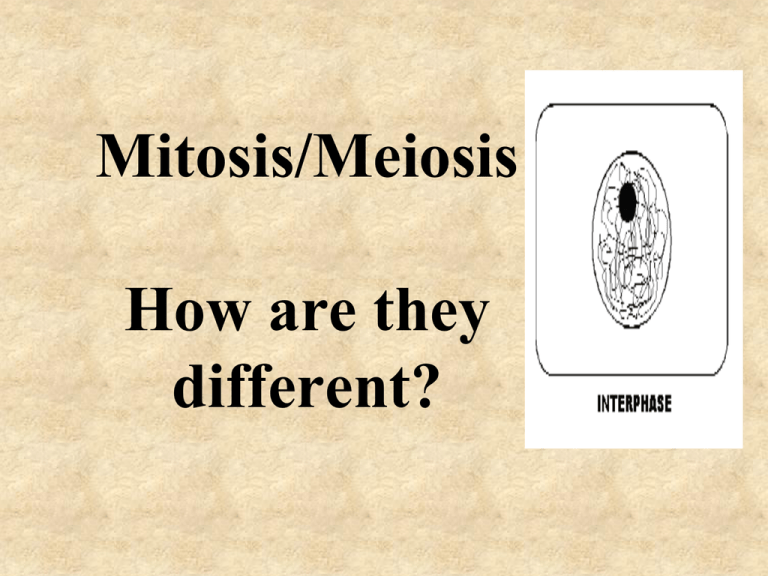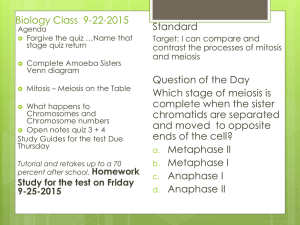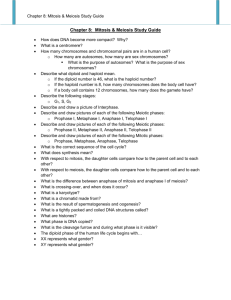Chapter 13 PowerPoint review
advertisement

Mitosis/Meiosis How are they different? The exchange of DNA between the chromatid arms on homologous pairs is called ________________ Crossing over This type of cell division used by bacteria to reproduce Binary fission The mixing up of maternal and paternal chromosomes as they move apart during anaphase I is called ______________ Independent assortment The pairing up of homologous chromosomes during prophase I synapsis is called _________________ This diagram is showing _________________ Crossing over During which phase does this happen? PROPHASE I of meiosis Is it MITOSIS or MEIOSIS? mitosis Makes 2 daughter cells ______________ meiosis Makes haploid cells _______________ Divides twice but meiosis copies DNA once __________________ mitosis Used to repair injuries ______________ Is it MITOSIS or MEIOSIS? Meiosis Makes 4 daughter cells ______________ mitosis Makes diploid cells _______________ mitosis Copies DNA every __________________ time it divides meiosis Used to make gametes ______________ Is it MITOSIS or MEIOSIS? Makes 2n cells ______________ mitosis Crossing over happens _______________ meiosis mitosis Used when organisms _________________ grow bigger meiosis Used in sexual reproduction ___________ Is it MITOSIS or MEIOSIS? meiosis Testes and ovaries do it ____________ mitosis Body cells do it _______________ meiosis Crossing over happens ____________ Divides twice ______________ meiosis in a row Is it MITOSIS or MEIOSIS? meiosis Independent assortment_____________ happens mitosis Divides just once_______________ meiosis Used in oogenesis __________________ Makes cells identical to parent cell __________________ mitosis Type of cell division shown meiosis Body organ where you would expect to see the above happen Ovary or testes Type of cell division shown mitosis Tell one reason why a cell would do this Grow organism bigger Repair injuries Replace worn out cells Asexual reproduction IN humans where does oogenesis happen? ovaries IN plants and some algae the diploid multicellular organism is called a ________________ sporophyte The small cells produced when the cytoplasm divides unevenly during Polar bodies oogenesis are called ______________ Producing offspring without using sperm or eggs in which the DNA comes from only 1 parent Asexual reproduction TRUE or FALSE Polar bodies will go on to become mature eggs FALSE; they will die The production of mature sperm is spermatogenesis called ___________________ Type of reproduction in which offspring are produced by combining the genetic material from 2 parents Sexual reproduction A cell with only one copy of each chromosome is called ___________ Haploid OR 1n A cell which has 2 copies of every chromosome is called _____________ diploid OR 2n Type of division that makes daughter cells which are different from the parent cell and different from each other meiosis The production of a mature egg is called ____________________ oogenesis Phase in which INDEPENDENT ASSORTMENT happens Anaphase I Name 2 ways the DNA in cells gets recombined in new ways during meiosis Crossing over OR independent assortment Phase during which SYNAPSIS happens Prophase I Spermatogenesis produces ____ 4 mature sperm cells Phase in which CROSSING OVER happens Prophase I How many mature eggs are produced during oogenesis? Only 1; the other 3 are polar bodies Chromosomes that do NOT determine sex are called ____________ autosomes Tell one phase that is different in meiosis than in mitosis Prophase I- Synapsis & crossing over Anaphase I- homologous partners separate instead of sister chromatids; independent assortment Metaphase I- homologous pairs line up together Interphase II- No DNA is copied The group of 4 chromatids of a homologous pair is called a ________________ tetrad This picture of an organism’s chromosomes is called a karyotype _______________ How many autosomes do humans have? 44; 46 – 2 sex chromosomes A human with 2 X chromosomes is a _________ female male female The joining of sperm and egg cells fertilization is called _________________ A fertilized egg is called a _________________ zygote Tell how metaphase I and metaphase II are different Metaphase I- homomolgous partners line up together Metaphase II- chromosomes line up separately IN humans where does spermatogenesis happen? testes In plants and some algae the haploid multicellular organism is called a ________________ gametophyte A human cell containing 22 autosomes and a Y chromosome is a. a somatic cell of a male. b. a zygote. Sperm c. a somatic cell of a female. d. a sperm cell. e. an ovum. cell Homologous chromosomes move toward opposite poles of a dividing cell during a. mitosis. Meiosis I b. meiosis I. c. meiosis II. d. fertilization. e. binary fission. Campbell and Reese Self quiz Meiosis II is similar to mitosis in that a. homologous chromosomes synapse. b. DNA replicates before the division. c. the daughter cells are diploid. D d. sister chromatids separate during anaphase. e. the chromosome number is reduced. If the DNA content of a diploid cell in the G 1 phase of the cell cycle is x, then the DNA content of the same cell at metaphase of meiosis I would be a. 0.25 x. Still X; chromosomes b. 0.5 x . haven’t split yet c. x. d. 2 x. e. 4 x. Campbell and Reese Self quiz Meiosis II is similar to mitosis in that a. homologous chromosomes synapse. b. DNA replicates before the division. c. the daughter cells are diploid. D d. sister chromatids separate during anaphase. e. the chromosome number is reduced. The immediate product of meiosis in a plant is a a. spore. b. gamete. SPORE c. sporophyte. d. gametophyte. e. zygote. Campbell and Reese Self quiz Meiosis II is similar to mitosis in that a. homologous chromosomes synapse. b. DNA replicates before the division. c. the daughter cells are diploid. D d. sister chromatids separate during anaphase. e. the chromosome number is reduced. If the DNA content of a diploid cell in the G 1 phase of the cell cycle is x, then the DNA content of the same cell at metaphase of meiosis I would be a. 0.25 x. Still X; chromosomes b. 0.5 x . haven’t split yet c. x. d. 2 x. e. 4 x. Campbell and Reese Self quiz If the DNA content of a diploid cell in the G 1 phase of the cell cycle is x, then the DNA content of the same cell at metaphase of meiosis I would be a. 0.25 x b. 0.5 x 2X cell copies DNA in S after c. x d. 2 x G1, but hasn’t split yet e. 4 x If we continued to follow the cell lineage from the cell above, then the DNA content at metaphase of meiosis II would be a. 0.25 x X- Back to X again; b. 0.5 x c. x Cell has reduced # in meiosis I d. 2 x e. 4 x Campbell and Reese Self quiz Multicellular haploid organisms a. are typically called sporophytes. b. produce new cells for growth by meiosis. C c. produce gametes by mitosis. d. are found only in aquatic environments. e. are the direct result of fertilization. Crossing over usually contributes to genetic variation by exchanging chromosomal segments between a. sister chromatids of a chromosome. b. chromatids of nonhomologues. B c. nonsister chromatids of homologues. d. nonhomologous loci of the genome. e. autosomes and sex chromosomes. Campbell and Reese Self quiz In comparing the typical life cycles of plants and animals, a stage found in plants but not in animals is a a. gamete. b. zygote c. multicellular diploid. d. multicellular haploid D Campbell and Reese Self quiz Which of the following life cycles is seen in plants? A Animals B Plants & some algae B C Most fungi & some protists Which of the following life cycles is seen in animals? A Animals B Plants & some algae A C Most fungi & some protists The following life cycles is seen in animals. Haploid gametes fuse to produce a 2n zygote via which process? FERTILIZATION The following life cycles is seen in animals. Diploid organisms produce haploid gametes via which process? MEIOSIS The following life cycles is seen in animals. A diploid zygote becomes a diploid multicellular adult via which process? MITOSIS The following life cycles is seen in plants and some algae. Diploid organisms produce haploid spores via which process? MEIOSIS The following life cycles is seen in plants and some algae. Haploid spores produce haploid multicellular gametophytes via which process? MITOSIS The following life cycles is seen in plants and some algae. Haploid multicellular gametophytes produce haploid gametes via which process? MITOSIS The following life cycles is seen in plants and some algae. Haploid gametes produce a diploid zygote via which process? FERTILIZATION Prophase I Metaphase I Anaphase I Telophase I Interphase I Prophase II Metaphase II Anaphase II Telophase II Interphase II INTERPHASE I or DNA II ________________ is all spread out as chromatin and nuclear envelope & nucleoli are visible PROPHASE I ________________ Chromatin condenses; homologues loosely start pairing along their lengths ANAPHASE II ________________ METAPHASE I Sister chromatids separate ________________ Homologous pairs line up in middle of cell Prophase I Metaphase I Anaphase I Telophase I Interphase I Prophase II Metaphase II Anaphase II Telophase II Cytokinesis METAPHASE II Replicated chromosomes lined up ________________ along equator CYTOKINESIS Division of cells produce four ________________ haploid cells METAPHASE I or IIKinetochores ________________ chromatids attach to sister ________________ TELOPHASE I Each half of the cell has a haploid set of chromosomes; cells still joined







